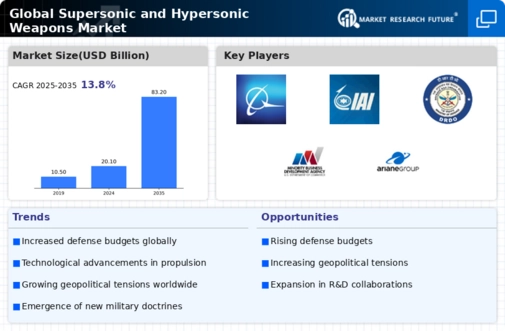Geopolitical Tensions
Geopolitical tensions are a significant driver of the Global Supersonic and Hypersonic Weapons Market Industry. Ongoing conflicts and rivalries among major powers, particularly in regions such as Eastern Europe and the Asia-Pacific, are prompting nations to bolster their military capabilities. The perceived threat from adversaries has led to an arms race, with countries investing heavily in hypersonic technologies to maintain strategic superiority. For instance, Russia's development of the Avangard hypersonic glide vehicle has raised concerns among NATO allies, prompting increased investments in similar technologies. This environment of uncertainty and competition is likely to sustain demand for hypersonic weapons in the coming years.
Market Growth Projections
The Global Supersonic and Hypersonic Weapons Market Industry is projected to experience substantial growth in the coming years. With a market value of 20.1 USD Billion in 2024, it is expected to reach 83.2 USD Billion by 2035, indicating a robust compound annual growth rate of 13.8% from 2025 to 2035. This growth trajectory reflects the increasing demand for advanced military capabilities and the strategic importance of hypersonic technologies in modern warfare. As nations prioritize the development and deployment of these systems, the market is poised for expansion, driven by both technological advancements and geopolitical factors.
Increasing Defense Budgets
The Global Supersonic and Hypersonic Weapons Market Industry is experiencing a surge in defense budgets across various nations. Countries such as the United States, Russia, and China are allocating substantial resources to enhance their military capabilities. For instance, the U.S. defense budget for 2024 is projected to exceed 800 billion USD, with a significant portion directed towards advanced weaponry, including hypersonic technologies. This trend indicates a growing recognition of the strategic advantages offered by these weapons, which are capable of evading traditional missile defense systems. As a result, the market is expected to grow from 20.1 USD Billion in 2024 to 83.2 USD Billion by 2035, reflecting a compound annual growth rate of 13.8% from 2025 to 2035.
Technological Advancements
Technological advancements play a pivotal role in shaping the Global Supersonic and Hypersonic Weapons Market Industry. Innovations in materials science, propulsion systems, and guidance technologies are enabling the development of more efficient and effective hypersonic weapons. For example, advancements in scramjet technology are facilitating sustained hypersonic flight, which enhances the range and accuracy of these weapons. Furthermore, research and development initiatives by defense agencies and private sector firms are accelerating the pace of innovation. This technological evolution not only improves the performance of existing systems but also paves the way for new applications, thereby expanding the market's potential.
Emerging Military Strategies
Emerging military strategies are reshaping the Global Supersonic and Hypersonic Weapons Market Industry. Modern warfare increasingly emphasizes rapid response capabilities and precision strikes, which hypersonic weapons are uniquely positioned to provide. Military doctrines are evolving to incorporate these advanced systems as essential components of deterrence and offensive strategies. For example, the U.S. military's focus on 'multi-domain operations' highlights the need for fast and agile weaponry that can operate across land, sea, air, space, and cyber domains. This shift in strategic thinking is likely to drive further investment in hypersonic technologies, as nations seek to adapt to the complexities of contemporary warfare.
Increased Collaboration and Partnerships
Increased collaboration and partnerships among nations and defense contractors are influencing the Global Supersonic and Hypersonic Weapons Market Industry. Joint development programs and international agreements are facilitating knowledge sharing and resource pooling, which can accelerate the development of hypersonic technologies. For instance, the collaboration between the United States and Australia on hypersonic research aims to enhance both nations' capabilities in this domain. Such partnerships not only reduce costs but also foster innovation through diverse expertise. As countries recognize the benefits of collaborative efforts, the market is likely to see a rise in joint ventures and cooperative projects, further driving growth.

















Leave a Comment